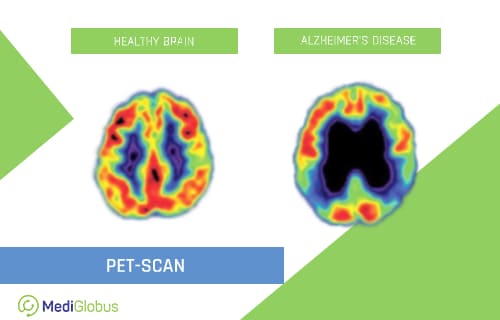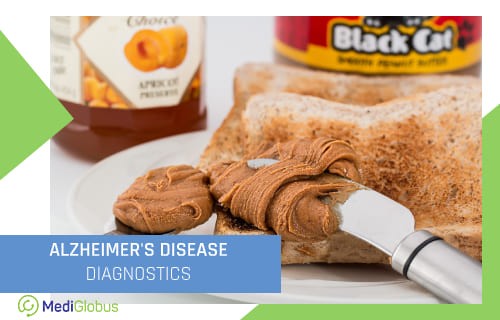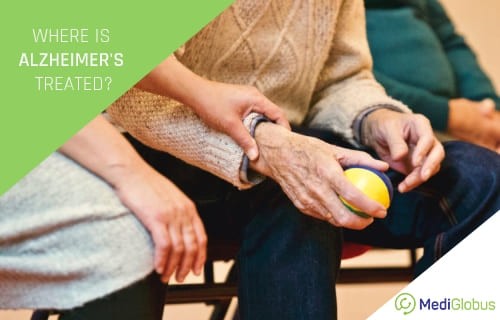Alzheimer’s disease is one of the most common types of senile dementia. The main observable symptoms are disordered memory, thinking, and behavior. It mostly affects elderly people, with 44 million affected living today.
Scientists are actively looking for a cure for Alzheimer’s disease. So far, the treatment offered in clinics can significantly slow down the course of the disease and the severity of its symptoms. Find out what modern methods can detect Alzheimer’s disease at its earliest stages in this article.
Alzheimer’s disease affects brain cells, also known as neurons. Changes in metabolism prevent these cells from normally transmitting electronic impulses.
Long before the first symptoms appear, neurons accumulate so-called beta-amyloids and tau-proteins. Like plaques, they prevent nutrients from reaching healthy cells. In the early stages of the disease, the brain is able to compensate for the deficiency, and outwardly this “starvation” of cells does not manifest itself in any way.
But over time, the amount of protein plaques increases. Immunity tries to fight, destroying the harmful protein, as well as dead and dying cells. The number of healthy neurons drops rapidly, and they can’t cope with their functions. All of which causes the symptoms known to be Alzheimer’s.

Signs of early Alzheimer’s:
Forgetfulness;
Difficulties with planning;
Difficulties with performing everyday tasks;
Confusion in time and space;
Communication, reading and writing problems;
Changes in personality and behavior.
Most people who suffer from Alzheimer’s disease get diagnosed for the first time at age 65+. However, modern research shows that the destructive processes in brain cells begin 20 years before the patient or his relatives begin to notice the first symptoms. This means that the disease can be detected and treated much earlier than previously thought.
WHO IS AT RISK FOR ALZHEIMER’S DISEASE?
Foremost, people whose relatives suffer from this disease are at risk of developing it themselves. Alzheimer’s dementia has a genetic component, which means that it’s inherited. At the same time, it is important to remember that genes do not guarantee 100% that the disease will occur. Other significant factors include head injuries and cardiovascular diseases.
HOW CAN PEANUT BUTTER IDENTIFY EARLY ALZHEIMER’S DISEASE?

Researchers from the University of Florida have found an interesting pattern. One of the first senses to begin to deteriorating during dementia is smelling. They found that in patients with Alzheimer’s, the left nostril becomes less sensitive than the right one. This is because the destructive processes in the left brain hemisphere are happening faster.
In order to test this out, scientists offered some people to sniff peanut butter with their right and left nostrils. People who subsequently developed Alzheimer’s needed to get 10 cm closer to the jar to sense the smell with their left nostril. In general, their sensitivity to smells was weaker than that of healthy test subjects.
Although this discovery is fascinating, it is not yet used as a separate diagnostic method. Many doctors doubt that the “peanut test” can distinguish early Alzheimer’s from other types of dementia and brain lesions.
EARLY DIAGNOSTIC OF ALZHEIMER’S DISEASE
AMYLOID PET
Amyloid PET-scanning allows doctors to see beta-amyloid proteins inside the subject’s brain. The procedure is similar to an MRI. The patient is placed in a scanner where they need to lie still for a while. The nurse injects a substance that reacts with the proteins associated with Alzheimer’s. In the next room, the specialists can have a good look at the patient’s brain. If the malignant protein has already started to spread, it will light up in the image.
The accuracy of this scan is about 87%. Because of this, none of the available methods are used by themselves.
FDG-PET
During the FDG-PET scan, the patient is also placed in the scanner. However, this time doctors are looking at different indicators. Instead of contrast dye, Glucose analog is used. Healthy cells absorb and process it quickly, but cells affected by Alzheimer’s do not.
Drugs that are injected during PET scanning have a short half-life and are completely eliminated from the body in a few hours.
This is an older method, and its accuracy is about 80%.
Spinal fluid test
In this method, the doctor collects fluid from the patient’s spinal cord using a special needle. This procedure is called a lumbar puncture. It is performed under local anesthesia. The obtained substance is sent to the laboratory, where it is examined for traces of beta-amyloids and tau-proteins.
Although the lumbar puncture is considered an invasive procedure, its advantage is that no radioactive substances are used.
The accuracy of the method is 71-87%.
WHERE IS ALZHEIMER’S DISEASE TREATED?

The best clinics for treating Alzheimer’s disease are located in Israel, Spain, Germany, Turkey, the Czech Republic, and South Korea. Their advantage is that they have state-of-the-art equipment for diagnostics and treatment, as well as the experience of their doctors.
Ichilov Hospital in Tel Aviv uses modern NeuroAD and Brainsway devices. They treat Alzheimer’s disease with transcranial magnetic stimulation. With their use, significant improvements can be seen already in 12 weeks, which is a good result in the treatment of this disease.
The Quironsalud network in Spain, the Liv University Hospital in Turkey, Korean Soon Chun Hyang Hospital and Motol University Hospital in the Czech Republic have also achieved impressive results in the treatment of Alzheimer’s disease. Among them, treatment in Turkey and Korea is the cheapest.
HOW TO PREVENT ALZHEIMER’S DISEASE?
Although you can’t dismiss hereditary factors, there are several ways you can avoid or slow down the onset of Alzheimer’s.
Education. A good education in the first third of life reduces the risk of Alzheimer’s development by 8%. By continuing to train your thinking, you can protect your neurons or slow down the development of dementia.
Maintaining good hearing and vision. Do not delay going to your doctor if you have difficulty seeing or hearing. Through the weakened organ, the brain does not receive enough stimulation, which causes weakening. This problem is easily solved with hearing aids and glasses.
Physical exercise. This can be sports or dancing. It is important not only to keep your body in shape, but also not to perform movements without thinking. You have to be fully involved, plan your movements and think about the next step.
Communicating with other people. Loneliness affects both the psychological state of a person and brain health.
Healthy lifestyle. Diabetes, high weight, and cardiovascular diseases are among the risk factors. Quit smoking, alcohol abuse and having an unbalanced diet.
By following all these rules, the risk of Alzheimer’s disease can be reduced by 35%.
If you are interested in the diagnostics and treatment of Alzheimer’s disease, please contact the Mediglobus coordinators. They will answer all your questions and help you find the most suitable hospital and doctors. We can also help you with travel arrangements, paperwork, and any other issues that may arise.





